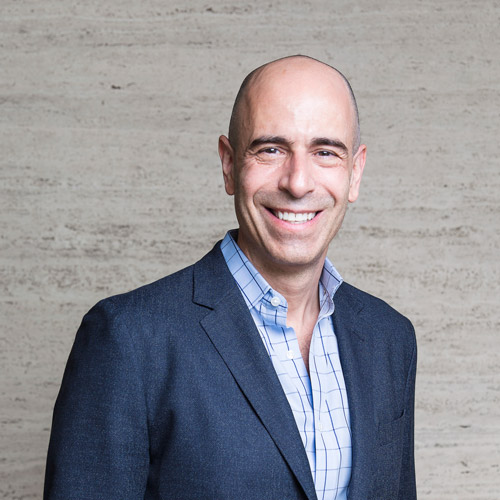When something needs fixing in any part of Verizon’s portfolio (which contains 100 million square feet of buildings, underground vaults, central offices, and infrastructure in the United States), it goes to Courtney Mezinis’s team. As Verizon’s executive director of global real estate operations, the core operations are under her care.
“All work requests—whether a light is out, a temperature needs adjustment, or a major repair is required—go through my operations team,” she says. Mezinis estimates that the operations team receives more than 300,000 work requests per year.
The team maintains building services, which includes managing “soft services,” such as the cafeteria, concierge, mail rooms, print services, and employee moves.
“Between our internal employees and our outsourced strategic partners, there are about 1,000 people providing services in over 5,000 buildings,” she says. “I’m always thinking about how I can best support my team—from the janitors, to the landscapers, to the building mechanics. I have a great team [that] I completely trust, but I like to regularly get out and put my own eyes to what’s going on in these buildings since I’m still learning about Verizon’s portfolio. With 100 million square feet of infrastructure, there’s a lot to learn.”
If that weren’t enough, Mezinis is also responsible for driving the global real estate division’s energy programs, managing Verizon’s sizable annual utility budget, including 10.6 billion kWh of electrical usage, and 3 billion gallons of water consumption.
Verizon replaces up to 120 roofs annually in order to ensure they are sound. To keep costs down, the company tries to bundle roofs as a package program with its vendor-partners. Mezinis estimates that Verizon spends $150 million each year on proactive projects like roofing and mechanical upgrades. The roof inspections are ongoing and prioritization of building projects is based on need. “I’m always looking at what’s coming up next based on the availability of funds and the importance of the building to Verizon,” Mezinis says.
Her energy team processes more than 110,000 utility invoices each month and conducts both pre-pay and post-pay audits to ensure billing accuracy.
“My team also implements hedging strategies for approximately $280 million worth of deregulated electric and natural gas contracts, and systematically reviews all available utility tariffs to ensure our buildings are on the best possible tariff based on their electric-usage patterns,” she says.
Mezinis is also spearheading several major sustainability initiatives across the portfolio, one of which will reduce annual water consumption by 200 million gallons—primarily through repair and replacement of the company’s underground cable dehydrator architecture and through improved cooling tower maintenance programs. In addition to water reduction, she’s deploying electric vehicle charging stations and plans to have them installed at 50 key employee locations by 2018. She’s also committed to obtain Energy Star certification at all eligible wireless retail buildings. Her efforts have helped Verizon earn the Department of Energy’s Energy Star Partner of the Year award for the past four years.
Perhaps what is least surprising, she says, is that managing these multiple responsibilities successfully can be challenging.
“We find our biggest challenge, in addition to the size and age of the portfolio, to be a lack of centralized surveillance,” Mezinis says. “Being able to understand how our buildings are performing at any given time is critical to being able to operate them as efficiently as possible. Implementation of extensive BMS upgrades and use of smart building technologies in our largest energy consuming locations is therefore a focus which we will continue to pursue.”
Mezinis stepped into her Verizon role three years ago after a stint as head of corporate real estate for Avaya. At Avaya, she was tasked with downsizing the portfolio from 15 million to about 5 million square feet. She also managed all aspects of real estate, which helped her hit the ground running when it came to maintaining the vast and aging Verizon portfolio.
“We have implemented quite a bit of transformation at Verizon,” Mezinis says. In order to maintain the infrastructure while managing costs, she outsourced some operations to two strategic partners and increased focus on performing preventative maintenance on equipment. “We’re [now] proactively maintaining equipment instead of waiting for it to break,” she says.
With almost 20 years in corporate real estate, Mezinis’s work with Verizon has been her greatest challenge yet. Overseeing such a complex portfolio presents daily crises, but she says seeing a project fully implemented to improve the workplace for employees and the service to customers makes it all worthwhile.
There are several large infrastructure projects that Mezinis and her team have handled that demonstrate how investment in such work is key to keeping Verizon’s network running smoothly. “Making prescriptive capital investment for the buildings yields the best return from the point of view of our network reliability, as well as our real estate.” Mezinis spoke with American Builders Quarterly about some of those projects.
FACADE RENOVATION IN NEW JERSEY
Timeline: 1-2 years
In areas such as New York and New Jersey, most of the buildings have been around for at least a century, and their age can show. One of Verizon’s Newark office buildings signaled a problem when a sizable crack became evident at the top of the 10-story building. The operations team sent structural engineers to find out what was going on and they found significant cracking and displacement of the face brick and backup masonry of the façade at the top of the building.
The first step was to prevent additional damage to the building and ensure pedestrian safety below by installing an emergency restraint system and protective scaffolding around portions of the building.
Mezinis’s team then looked at multiple solutions to determine the most cost-effective solution in terms of upkeep and ongoing maintenance. They ultimately decided to fabricate new terra cotta panels—matching the existing architectural character of the building—to replace the existing crumbling façade where needed. The replacement process is expected to take eight to 10 months.
CHILLER PLANT SEPARATION IN MANHATTAN
Timeline: 2 years
A few years ago, Verizon monetized a portion of an underutilized central office in Manhattan by selling a piece of the building to the neighboring NYU Medical Center. The two organizations shared the infrastructure, the energy, and the utilities. However, keeping a consistent cooling supply to both the hospital and Verizon’s technical equipment was problematic. The two decided to separate their infrastructure in order to gain more control over their individual needs. The separation project resulted in two massive temporary chillers placed out on a residential street in Manhattan where they created quite a bit of noise for nearby neighbors.
“There were quite a few nuances to the project to ensure our equipment would continue operating while we were under construction for our future needs,” Mezinis says. However, both organizations now have their own infrastructure and are operationally independent—and residents are pleased to have the noise obstruction behind them.

Pedestrian Bridge restoration in Cary, North Carolina
Timeline: 1.5 years
During a routine inspection, the maintenance team noticed degradation in the undercarriage of a pedestrian bridge in the Cary, North Carolina, Verizon campus. The bridge connects the building to the parking deck, which employees cross daily. As the repair crew began to investigate the extent of damage, they peeled back the undercarriage and patched any crumbling areas. Then, city officials asked Verizon to go back and redesign the bridge repair after two similar bridges in the Raleigh metropolitan area had collapsed, sparking statewide safety concerns.
So with the help of an architect, engineer, and repair team, the team reopened the bridge project, reassembled the scaffolding, and put in the extra reinforcements and a drainage system at city officials’ request to ensure the bridge was secure. It’s typical, Mezinis says, of how a smaller project can become much more involved than originally estimated.



